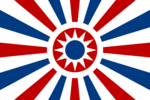IIWiki:Today's featured article: Difference between revisions
(May 2024 Update) |
(June 2024 Update) |
||
| Line 1: | Line 1: | ||
<div style="float:left;margin:0.5em 0.9em 0.4em 0;">[[File: | <div style="float:left;margin:0.5em 0.9em 0.4em 0;">[[File:ZhoushengFlag.png|150px]]</div> The '''Zhoushi language''' (Zhoushi: ''Ʒөшinчina'') is a [[wikipedia:Slavic_languages|Slavic language]] with major influence of local languages, that arose as a [[wikipedia:Mixed language|mixed language]] or [[wikipedia:Pidgin|pidgin]] of sorts in the nation of [[Zhousheng]], a former colonial outpost of [[Suidenland]]. It is based on a slavic grammatic and linguistic base, especially inspired by [[Bogmian language|Bogmian]], [[wikipedia:Czech language|Suiden]] and [[Belgorian language|Belgorian]] languages, but has many major influences of other languages located in the region, especially Yu language|Standard Yu, [[wikipedia:Khmer language|Preimeai]], [[wikipedia:Mandarin Chinese|Mandarin Chinese]] and [[wikipedia:Kagate language|Syuba]]. The language has a [https://en.wikipedia.org/wiki/Slavic_languages slavic root and grammar], however, unlike other slavic languages, has 8 grammatical cases (other have 7 or 6). Also, there are about 700 Zhengian words in present day Zhoushi language, they are inflected using Bogmian grammar. Old Zhengian, having been descendant out of [https://en.wikipedia.org/wiki/Austroasiatic_languages Prei-Phnom languages], was slowly assimilated into Slavic grammar, having transformed into Slavic Zhengian. Because of the Zhengian accents profilerating, Zhoushi language has 40 unique phonemes, 2 of which are exclusive to Zhoushi language ('''[[Zhoushi language|See more...]]''') | ||
<div align="right"> | <div align="right"> | ||
Revision as of 01:15, 7 June 2024
The Zhoushi language (Zhoushi: Ʒөшinчina) is a Slavic language with major influence of local languages, that arose as a mixed language or pidgin of sorts in the nation of Zhousheng, a former colonial outpost of Suidenland. It is based on a slavic grammatic and linguistic base, especially inspired by Bogmian, Suiden and Belgorian languages, but has many major influences of other languages located in the region, especially Yu language|Standard Yu, Preimeai, Mandarin Chinese and Syuba. The language has a slavic root and grammar, however, unlike other slavic languages, has 8 grammatical cases (other have 7 or 6). Also, there are about 700 Zhengian words in present day Zhoushi language, they are inflected using Bogmian grammar. Old Zhengian, having been descendant out of Prei-Phnom languages, was slowly assimilated into Slavic grammar, having transformed into Slavic Zhengian. Because of the Zhengian accents profilerating, Zhoushi language has 40 unique phonemes, 2 of which are exclusive to Zhoushi language (See more...)
KEEP THIS ONE PARAGRAPH IN LENGTH so it doesn't push the main page section down below the other section.
